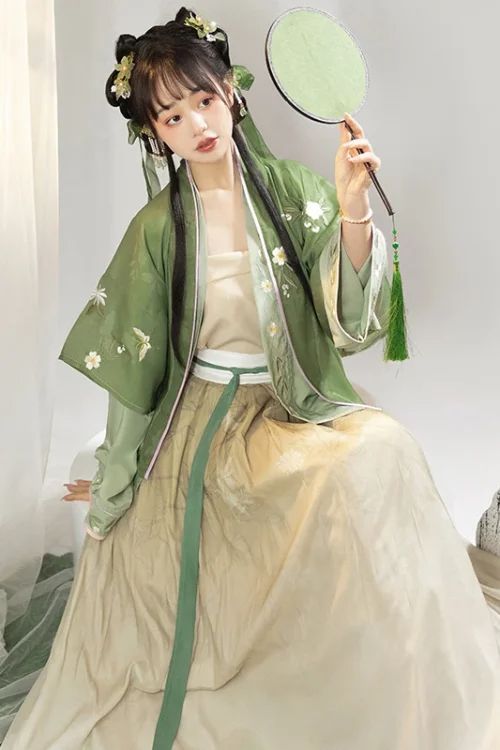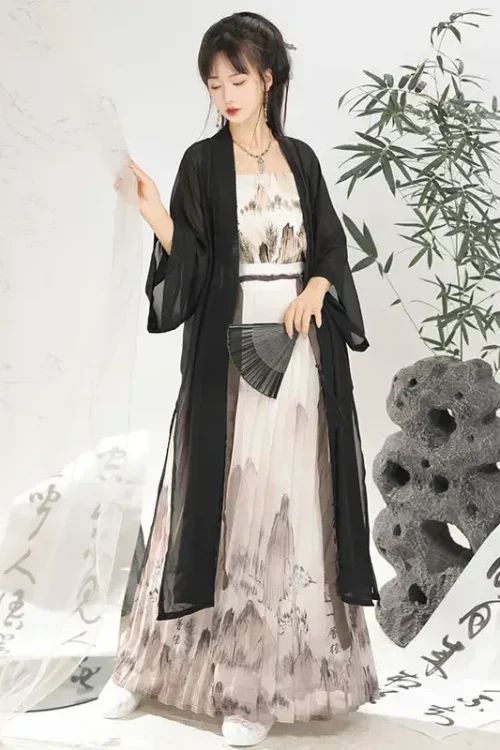Modernizing the 汉服 Water Wave Pattern: Techniques and Innovations
The Hanfu, a traditional Chinese garment, has captivated fashion enthusiasts with its intricate designs and flowing silhouettes. Among its most iconic patterns is the water wave, a mesmerizing motif that evokes the gentle ripples of a tranquil pond. However, as fashion evolves, so too must the techniques used to create these timeless patterns.

Innovative Techniques
One innovative approach to modernizing the water wave pattern is through the use of digital printing. This technology allows for precise and vibrant reproduction of the pattern, enabling designers to experiment with new color combinations and variations. By incorporating digital printing into the production process, designers can create water wave patterns that are both authentic and contemporary.
Another technique that has gained popularity is laser cutting. This method involves using a laser to precisely cut the fabric, creating intricate and delicate patterns. Laser cutting allows for the creation of water wave patterns with sharp, clean lines, adding a modern touch to the traditional design.
Exploring New Materials
In addition to technological advancements, designers are exploring new materials to create water wave patterns. Fabrics such as organza, silk, and chiffon allow light to pass through, creating a shimmering and dynamic pattern that captures the essence of water. These materials complement the flowing nature of Hanfu, enhancing the ethereal quality of the garment.
Modern Embellishments and Techniques
Designers are also experimenting with unconventional embellishments to enhance the water wave pattern. By incorporating beads, sequins, and embroidery, they add texture and depth to the design, mimicking the gentle undulations of water. These embellishments create a sense of movement and fluidity, elevating the aesthetic appeal of Hanfu.
Cultural and Fashion Evolution
The modernization of the Hanfu water wave pattern reflects the evolving cultural landscape. As China embraces modernity, its traditional arts and crafts are being reinterpreted to suit contemporary tastes. By incorporating innovative techniques and materials, designers preserve the essence of the Hanfu while propelling it into the future.
In conclusion, the modernization of the Hanfu water wave pattern through digital printing, laser cutting, new materials, and embellishments demonstrates how tradition can blend with innovation. These changes not only enhance the aesthetic appeal of the Hanfu but also reflect the evolving cultural trends of China.
Embracing Contemporary Aesthetics: Reimagining the Water Wave Pattern in Hanfu
The water wave pattern, a timeless motif in Hanfu, embodies the fluidity and grace of water. However, as Hanfu evolves to meet contemporary aesthetics, it is essential to modernize this pattern to resonate with modern sensibilities.

Geometric Elements in Modern Water Wave Patterns
One approach to reimagining the water wave pattern is to incorporate geometric elements. By introducing straight lines and sharp angles, the pattern gains a more structured and modern look. Techniques like pleating, embroidery, or even laser cutting can achieve this blend of tradition and modernity.
Modern Fabrics for a New Look
Experimentation with fabrics is another significant shift in Hanfu design. Traditional Hanfu fabrics, such as silk and cotton, are now complemented with modern materials like organza, mesh, and lace. These fabrics add a touch of transparency and lightness, offering a fresh, ethereal interpretation of the water wave motif.
Modern Color Schemes
In contrast to traditional Hanfu, which often featured muted tones, contemporary designs now embrace a broader color palette. Vibrant hues such as emerald green, sapphire blue, and fuchsia introduce a modern flair to the water wave pattern. These colors redefine the aesthetic while maintaining the timeless grace associated with Hanfu.
Scale and Placement of Water Wave Patterns
The scale and placement of water wave patterns in modern Hanfu designs also vary to align with contemporary trends. Subtle, smaller patterns offer understated sophistication, while bold, larger patterns make a more dramatic statement.
In conclusion, by blending geometric elements, experimenting with fabrics and colors, and adjusting the scale and placement of patterns, designers are transforming the Hanfu water wave motif for modern tastes. These innovations preserve the traditional essence while making Hanfu relevant in today’s fashion landscape.
The Evolution of the Water Wave Pattern: From Tradition to 现代ity
The water wave pattern, a timeless motif in Chinese culture, has adorned Hanfu, the traditional Chinese garment, for centuries. While the essence of the pattern remains constant, its interpretation has evolved with time, adapting to contemporary tastes and innovations.

Geometric Transformations
One approach to modernizing the water wave pattern is the incorporation of geometric elements. Traditionally, the pattern is characterized by flowing curves that mimic the natural movement of water. However, designers are now breaking down these curves into angular shapes, introducing sharp lines and triangles to create a more structured and modern aesthetic.
Fabrics and Textures
Modern designers are also experimenting with a variety of fabrics and textures to breathe new life into the water wave pattern. While silk is traditionally used in Hanfu, new materials such as cotton, linen, and synthetic fabrics offer versatility. Varying the texture and drape of these fabrics creates a dynamic and visually interesting interpretation of the water wave motif, providing new depth to this ancient design.
Vibrant Color Palettes
Color plays a critical role in modernizing the water wave pattern. Whereas traditional Hanfu often featured soft, muted colors, contemporary designers are opting for vibrant and contrasting hues. The use of bold shades, such as electric blues, deep reds, and bright yellows, adds a modern twist while maintaining the integrity of the pattern.
Technological Advancements in Hanfu Design
In addition to experimenting with fabric and color, modern Hanfu designers have embraced technological advancements to enhance the water wave pattern. Digital printing and intricate embroidery techniques allow for greater precision and customization, creating unique and visually captivating patterns. These methods have led to more detailed and elaborate designs, elevating the water wave motif to new heights.
By blending traditional craftsmanship with cutting-edge technology, designers continue to push the boundaries of Hanfu design, ensuring that the water wave pattern remains a symbol of timeless elegance and cultural heritage.
Symbolism and Cultural Significance
Despite the modernization of the water wave pattern, its symbolism remains deeply rooted in Chinese culture. Water is associated with qualities such as purity, adaptability, and abundance, and the water wave pattern continues to embody these values. Modern interpretations of the pattern, therefore, not only serve an aesthetic purpose but also carry forward these important cultural messages.
Looking Ahead: Future of the Water Wave Pattern
As the water wave pattern continues to evolve, it will likely inspire even more innovative interpretations in the future. With advancements in technology and a growing interest in preserving cultural heritage through fashion, the water wave motif is poised to remain a key element in both traditional and contemporary Hanfu designs.
Innovative Interpretations of Traditional Hanfu Patterns
The water wave pattern has proven to be a resilient and adaptable motif, seamlessly transitioning from ancient tradition to modern fashion. As designers continue to explore new avenues for interpretation, the water wave motif stands at the intersection of cultural heritage and innovation.

Blending East and West
One way the water wave pattern is being modernized is through the fusion of Eastern and Western design elements. By combining the fluidity of the water wave motif with Western silhouettes and tailoring techniques, designers can create garments that resonate with both traditional and contemporary audiences. This blend of cultural influences highlights the universal appeal of the water wave pattern while allowing for fresh, exciting designs.
Sustainability in Hanfu Design
Another emerging trend is the incorporation of sustainability in modern Hanfu design. As environmental concerns grow, designers are exploring eco-friendly materials and production methods. Fabrics such as organic cotton and bamboo silk, paired with natural dyes, are being used to create water wave patterns that reflect both traditional craftsmanship and contemporary eco-conscious values.
Embellishments and 3D Textures
The incorporation of three-dimensional embellishments such as beads, sequins, and embroidery further enhances the water wave pattern. These tactile elements add texture and depth, creating a dynamic visual experience. By mimicking the undulating motion of water, these embellishments capture the essence of the water wave motif, bringing it to life in a way that is both visually stunning and innovative.
Cultural Preservation Through Fashion
While the water wave pattern is evolving to suit modern tastes, its role in preserving cultural heritage remains paramount. Hanfu, with its intricate designs and motifs, has become a symbol of national pride, and the revival of the water wave pattern is a testament to the enduring legacy of Chinese art and fashion. Through creative reinterpretation, designers are ensuring that the cultural significance of the water wave pattern remains relevant to contemporary audiences.
Timeless Beauty in a Modern Era
Ultimately, the modernization of the water wave pattern on Hanfu reflects the broader trend of cultural reinvention. As China embraces its rich history while adapting to the demands of modernity, the water wave pattern continues to represent the harmony between tradition and innovation. Its timeless beauty and symbolic depth ensure that this ancient motif will continue to inspire designers and fashion enthusiasts for generations to come.
The Future of Water Wave Patterns in Hanfu
The future of the water wave pattern in Hanfu design promises continued innovation and cultural evolution. As designers push the boundaries of traditional aesthetics, the water wave motif is likely to inspire even more creative interpretations.
Integration with Modern Technology
With advancements in technology, the integration of augmented reality (AR) and virtual reality (VR) into fashion design could offer immersive experiences of water wave patterns. Virtual try-ons and interactive design tools will allow users to explore different iterations of the water wave pattern, blending traditional beauty with cutting-edge technology.
Collaborations and Cross-Cultural Influences
Future developments may also see increased collaborations between Chinese designers and international fashion houses. These cross-cultural exchanges can introduce new perspectives and techniques, enriching the water wave pattern’s design language and expanding its global appeal.
Revival and Preservation
Efforts to revive and preserve traditional Hanfu garments, including those adorned with water wave patterns, will continue to play a crucial role. Institutions and cultural organizations are likely to support the preservation of traditional techniques while encouraging modern adaptations. This dual approach ensures that the water wave pattern remains a vibrant part of both historical and contemporary fashion.
Consumer Engagement and Trends
As consumer interest in traditional and heritage fashion grows, the water wave pattern’s role in Hanfu will be increasingly celebrated. Public engagement through exhibitions, fashion shows, and educational programs will highlight the pattern’s significance and adaptability, ensuring its continued relevance.
结论
The water wave pattern, with its rich history and symbolic meaning, will remain a key element in Hanfu design. Its evolution from traditional to modern contexts reflects the dynamic nature of fashion and culture. By embracing new techniques and ideas while honoring its origins, the water wave pattern will continue to captivate and inspire, bridging the gap between past and present.
